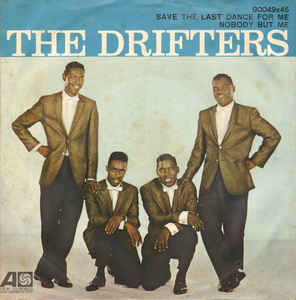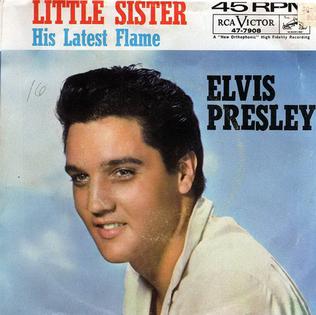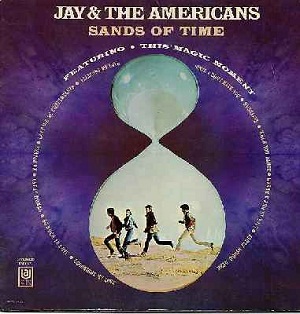Related Research Articles

Jerome Solon Felder, known professionally as Doc Pomus, was an American blues singer and songwriter. He is best known as the co-writer of many rock and roll hits. Pomus was inducted into the Rock and Roll Hall of Fame as a non-performer in 1992, the Songwriters Hall of Fame (1992), and the Blues Hall of Fame (2012).

Mortimer Shuman was an American singer, pianist and songwriter, best known as co-writer of many 1960s rock and roll hits, including "Viva Las Vegas". He also wrote and sang many songs in French, such as "Le Lac Majeur", "Papa-Tango-Charly", "Sha Mi Sha", "Un Été de Porcelaine", and "Brooklyn by the Sea" which became hits in France and several other European countries.
"Hushabye" is a song that was written by Doc Pomus and Mort Shuman in 1959 for the Brooklyn doo-wop quintet the Mystics. The group's recording of the song was a Top 20 hit.

"Save the Last Dance for Me" is a song written by Doc Pomus and Mort Shuman, first recorded in 1960 by American musical group the Drifters with Ben E. King on lead vocals. It has since been covered by several artists, including Dalida, the DeFranco Family, Emmylou Harris, Dolly Parton, and Michael Bublé.

"Can't Get Used to Losing You" is a song written by Jerome "Doc" Pomus and Mort Shuman, first made popular by Andy Williams in a 1963 record release, which was a number-two hit in both the US and the UK. Twenty years later, British band the Beat took a reggae re-arrangement to number three in the UK.

"This Magic Moment" is a song composed by lyricist Doc Pomus and pianist Mort Shuman. It was first recorded by The Drifters, with Ben E. King singing lead.

"Viva Las Vegas" is a 1964 song recorded by Elvis Presley written by Doc Pomus and Mort Shuman for his film of the same name, which along with the song was set for general release the year after. Although Elvis Presley never performed the song live, it has since become popular and often performed by others. The RIAA certified the single disc "Viva Las Vegas/What'd I Say" gold on March 27, 1992, having sold 500,000 copies in the United States.
"A Teenager in Love" is a song written by Doc Pomus and partner Mort Shuman. It was originally recorded by Dion and the Belmonts, and released in March 1959. It appeared on their album Presenting Dion and the Belmonts (1959). It reached number 5 on the Billboard pop charts.

"She's Not You" is a 1962 song recorded by Elvis Presley and released as a single on RCA Victor.

"(Marie's the Name) His Latest Flame" is a song recorded in a hit version by Elvis Presley and published by Elvis Presley Music in 1961. It was written by Doc Pomus and Mort Shuman and first recorded by Del Shannon on the album Runaway with Del Shannon, which was released in June 1961.

"Surrender" is a number 1 song recorded by Elvis Presley and published by Elvis Presley Music in 1961. It is an adaptation by Doc Pomus and Mort Shuman of the music of a 1902 Neapolitan ballad by Giambattista and Ernesto de Curtis entitled "Torna a Surriento". It hit number one in the US and UK in 1961 and eventually became one of his best-selling singles. Presley held the record for most consecutive number one singles on the Billboard Hot 100 before 1966, when The Beatles beat the record, with six consecutive number ones released between 1965 and 1966. That record eventually was broken in 1988 by Whitney Houston, who continues to hold the record today with seven. It would hold the record for most consecutive number ones by a solo artist until Houston broke that record with "So Emotional". This was one of 25 songs which Doc Pomus and Mort Shuman wrote for Presley. It has been recorded by many other artists, including Michael Bublé, The Residents and Il Volo.
"Turn Me Loose" is a song written by Doc Pomus and partner, Mort Shuman, upon the request of the managers of teen idol, Fabian Forte. The song became Fabian's first hit record, reaching number nine in the Billboard Hot 100 chart in 1959.

"Suspicion" is a 1962 song originally recorded by Elvis Presley written by Doc Pomus and Mort Shuman. It became a major hit in 1964 in a recording by Elvis Presley sound-alike Terry Stafford.

Andy Williams' Greatest Hits is a compilation album by American pop singer Andy Williams that was released in early 1970 by Columbia Records. It was not, however, as its title might suggest, strictly a hit singles compilation, although some of his biggest songs since joining Columbia were included. A couple of selections were never released as singles by Williams, and his signature song, "Moon River", was released in the 7-inch single format but only for jukeboxes. His six Cadence singles that made the Top 10 on Billboard magazine's Hot 100 are passed over for the inclusion of his number 11 hit from that label, "The Hawaiian Wedding Song", and 17 of his Columbia recordings that made the Hot 100 up until 1970 are left out here in favor of "Charade", which spent its one week on the chart at number 100.

Sands of Time is the seventh studio album by Jay and the Americans released on March 15, 1969. The album went to #51 on the Billboard 200 chart, reached #30 on the Cashbox chart, and #47 in Canada.

Wax Museum is the eighth studio album by Jay and the Americans released on February 28, 1970. The album went to #105 on the Billboard 200 chart, reached #68 on the Cashbox chart, and #71 in Canada. The album was the group's last charting album.
Bill Giant was an American songwriter whose work included over 40 songs for Elvis Presley.
John Leslie McFarland was an American popular music composer and arranger.

Things and Other Things is an album by American singer Bobby Darin, released in 1962. It reached number 45 on the Billboard 200. The single "Things" charted in the Top Five.

"Bad Boy" is a song by rock and roll singer Marty Wilde, released as a single in November 1959. It peaked at number 7 on the UK Singles Chart and number 45 on the Billboard Hot 100.
References
- ↑ "Jimmy Clanton, 'Go, Jimmy, Go' Chart Positions". musicvf.com. Retrieved August 7, 2021.
- ↑ "CHUM Hit Parade - January 25, 1960".
- ↑ My Best to You (1961) album cover
- ↑ "Top 100 Hits of 1960/Top 100 Songs of 1960". Music Outfitters. Retrieved August 7, 2021.
- 1 2 Halberstadt, Alex (April 28, 2009). Lonely Avenue: The Unlikely Life and Times of Doc Pomus. Hachette Books. p. 106. ISBN 978-0-7867-3229-6 – via Google Books.
- ↑ Emerson, Ken (September 26, 2006). Always Magic in the Air: The Bomp and Brilliance of the Brill Building Era. Penguin Publishing Group. p. 58. ISBN 978-1-101-15692-6 – via Google Books.
- ↑ Wayne, Harada (November 29, 1959). "The Honolulu Advertiser". p. 110. Retrieved August 7, 2021– via Newspapers.com.
- ↑ "Reviews of This Week's Singles". Billboard. Nielsen Business Media, Inc. November 9, 1959. p. 49.
- ↑ Schreiber, Charles J. (December 12, 1959). "New Sounds". The Gazette– via Newspapers.com.
- ↑ Southward, Walt (November 29, 1959). "Let's Talk Music". Hawaii Tribune-Herald– via August 7, 2021.
- ↑ "Go, Johnny, Go (1959)". AFI.com. American Film Institute . Retrieved August 7, 2021.